|
Broadstrike
|
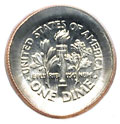
|
Coin struck without a collar, thus when the coin is struck
the metal is allowed to expand and increase in diameter. May be
centered or uncentered, but must not have any missing lettering or
design detail.
|
| |
|
Off center
|
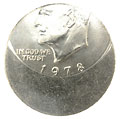
|
Coin struck without a collar and off center, different from
the uncentered broadstrike because part of the lettering or design
detail is missing.
|
| |
|
Mechanical doubling
|
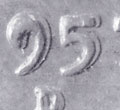
|
Often looks like a doubled die but is not. It is
caused by loose dies that twist slightly after coming into contact with
the planchet causing the die to slightly drag on the coin producing a
flat, shelf-like doubled appearance. Also under this classification is
excessive die wear and/or improper die annealing that will cause the
elements of the design to appear doubled simply because the lettering
and design elements are thick and mushy. Mechanical doubling usually
commands very little premium. Be especially careful of this error on
1969-S cents which can sometimes be mistaken for the very rare and
valuable 1969-S doubled die cent.
|
| |
|
Die break
|
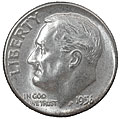
|
A chip out of the die into which metal from the planchet
will flow when the die strikes coins. It appears as a raised blob of
metal on the struck coins. When the die break is large it is sometimes
called a "cud."
|
| |
|
Cud
|
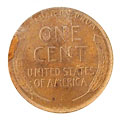
|
When a significant part of the edge of the die deteriorates and
falls off. The coins struck with this die exhibit a raised blank area
on that part of the design. Sometimes called "major die break"
|
| |
|
Caps or die caps
|
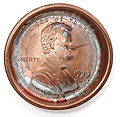
|
When a coin is struck and sticks to the die for
numerous strikes, the metal flows up around the die and the coin takes
on the shape of a bottle cap. A very eye appealing and desirable error.
|
| |
|
Capped die strike
|
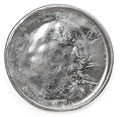
|
When a die cap error is occurring, the dies continue
to strike more coins even though a coin is capped around one of the
dies. If the coin is capped around the obv. die, the coins stuck with
that die will appear blank or have varying degrees of mushyness on the
obv. due to the obverse die being obstructed. If the cap stays on
indefinitely, eventually it will wear through the planchet and the coins
struck by that die will become less and less obstructed causing a
"late-stage" capped die strike where the image is less distorted.
|
| |
|
Indent
|
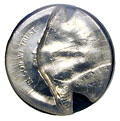
|
When a blank planchet partially overlaps another planchet in
the striking chamber and gets struck, the overlapping area on the struck
coin will exhibit a blank indented area from the other planchet being
struck into it.
|
| |
|
Brockage
|
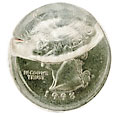
|
Occurs the same as an indent, except that a struck coin is
struck into a blank planchet leaving a mirror image impression, although
often quite distorted due to metal flow.
|
| |
|
Struck through error
|
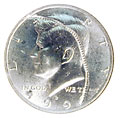
|
Occurs when a foreign object lies on top of the
planchet and leaves an impression of itself when struck into the coin.
A wide variety of objects have been reported including grease, string,
cloth, hair, plastic, bandaid, staples, etc.
|
| |
|
Weak strike or Die trial
|
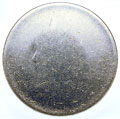
|
Occurs when there is insufficient pressure
from the dies to leave a full impression on the planchet. This can
occur for a variety of reasons but usually occurs when the power to the
presses is turned off and the dies continue to strike coins with less
and less pressure until coming to a stop. On such coins all the detail,
including the reeding on clad coins should exhibit extreme weakness. If
the coin is simply struck through grease, some details may be strong and
the edge reading will also be strong.
|
| |
|
Curved Clipped Planchet
|
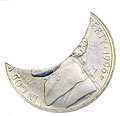
|
Planchets are punched from large thin metal
sheets. After a section of the sheet is punched, if the sheet fails to
be fed far enough ahead, the punch will overlap an already punched area
causing that planchet to have a circular "clip" of missing metal. A
good way to tell if the coin is an error or simply damage that occurred
outside the mint is to look for signs of metal flow into the blank area,
which indicates a genuine clip. This will appear as weakness and
thinness around the missing metal. There will also often be a
corresponding area of weakness on the rim of the opposite side of the
coin, known as the "Blakesley effect." A genuine clip will never show a
raised edge of metal bordering the missing metal (which usually
indicates shearing) and the details bordering the area of missing metal
should not be crisp.
|
| |
|
Straight clipped planchet
|
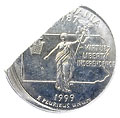
|
If the metal strip shifts during the
punching process and the punches overlap the straight side edge of the
strip, a straight area of metal will be missing from the planchet.
|
| |
|
Ragged clipped planchet
|
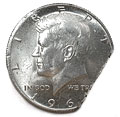
|
If the punches overlap the ragged ends of the
strip, a resulting ragged area of missing metal occurs.
|
| |
|
Wrong planchet/off metal
|
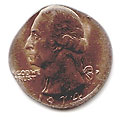
|
When a planchet is struck by a pair of dies
that do not correspond to the denomination intended for the planchet, a
wrong planchet error occurs. For example a Jefferson nickel struck on a
cent planchet will have the same weight and copper composition as a
cent. It will likely be smaller than a nickel, but probably slightly
larger than a cent because the nickel collar cannot restrain the smaller
cent planchet from expanding.
|
| |
|
Double Denomination
|
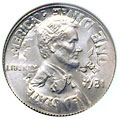
|
Occurs when an already struck coin is struck by a
pair of dies of a different denomination. These coins will show details
of both denominations. For example a cent struck on a struck dime
(often called an 11c piece) will have the planchet of a dime and details
of both a dime and a cent. Usually the details of the denomination of
the last dies to strike to coin are strongest and some double
denomination coins barely show any detail from the denomination of the
first strike.
|
| |
|
Clashed dies
|
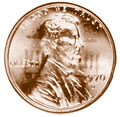
|
Occurs when there is a malfunction in the planchet
feeding mechanism and no planchet is fed into the striking chamber
allowing the dies to strike each other. The obv. die will leave an
impression in the rev. die and vice versa. Coins struck with these dies
will exhibit details of both the obv and rev. on each side of the coin.
The amount of detail can vary from barely discernable to very
noticeable.
|
| |
|
Lamination
|
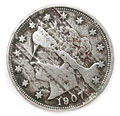
|
Dirt and impurities in the metal of the planchet can
manifest themselves as cracks and peels on the struck coin.
|
| |
|
Split planchet
|
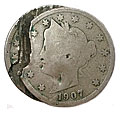
|
If the impurity is severe enough, it can case the
planchet to split into two halves obv. and rev. If the planchet splits
before the strike, the resulting coin will be thin and have detail on
both sides but often intermingled with rough striations from the
impurities. If the planchet splits after the strike, one side will have
full detail and the other side will be blank and striated. In either
case the coin will be thin.
|
| |
|
Missing Clad Layer
|
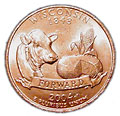
|
A clad coin with one of the clad layers missing either before the coin is struck or
which is loose and falls away after the strike. The side of the coin with the clad
layer missing will be copper colored showing the exposed copper core of the coin.
The other side of the coin is normal.
|
| |
|
Double Strike
|
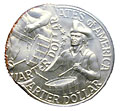
|
If a coin fails to be properly ejected from the striking chamber after
being stuck and the dies come down again to strike the coin again, a
double strike ocurs. Double strikes can occur with the second strike
off center or on-center. In the same way triple and multiply struck
coins occur.
|
| |